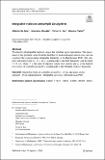| dc.contributor.author | De Sole, Alberto | |
| dc.contributor.author | Jibladze, Mamuka | |
| dc.contributor.author | Kac, Victor G. | |
| dc.contributor.author | Valeri, Daniele | |
| dc.date.accessioned | 2021-10-29T18:51:46Z | |
| dc.date.available | 2021-10-29T18:51:46Z | |
| dc.date.issued | 2021-09-09 | |
| dc.identifier.uri | https://hdl.handle.net/1721.1/136755 | |
| dc.description.abstract | Abstract
We classify all integrable triples in simple Lie algebras, up to equivalence. The importance of this problem stems from the fact that for each such equivalence class one can construct the corresponding integrable hierarchy of bi-Hamiltonian PDE. The simplest integrable triple (f, 0, e) in
$${\mathfrak {sl}}_2$$
sl
2
corresponds to the KdV hierarchy, and the triple
$$(f,0,e_\theta )$$
(
f
,
0
,
e
θ
)
, where f is the sum of negative simple root vectors and
$$e_\theta $$
e
θ
is the highest root vector of a simple Lie algebra, corresponds to the Drinfeld–Sokolov hierarchy. | en_US |
| dc.publisher | Springer Netherlands | en_US |
| dc.relation.isversionof | https://doi.org/10.1007/s11005-021-01456-4 | en_US |
| dc.rights | Creative Commons Attribution | en_US |
| dc.rights.uri | https://creativecommons.org/licenses/by/4.0/ | en_US |
| dc.source | Springer Netherlands | en_US |
| dc.title | Integrable triples in semisimple Lie algebras | en_US |
| dc.type | Article | en_US |
| dc.identifier.citation | Letters in Mathematical Physics. 2021 Sep 09;111(5):117 | en_US |
| dc.contributor.department | Massachusetts Institute of Technology. Department of Mathematics | |
| dc.identifier.mitlicense | PUBLISHER_CC | |
| dc.eprint.version | Final published version | en_US |
| dc.type.uri | http://purl.org/eprint/type/JournalArticle | en_US |
| eprint.status | http://purl.org/eprint/status/PeerReviewed | en_US |
| dc.date.updated | 2021-09-12T03:08:23Z | |
| dc.language.rfc3066 | en | |
| dc.rights.holder | The Author(s) | |
| dspace.embargo.terms | N | |
| dspace.date.submission | 2021-09-12T03:08:23Z | |
| mit.license | PUBLISHER_CC | |
| mit.metadata.status | Authority Work and Publication Information Needed | en_US |
